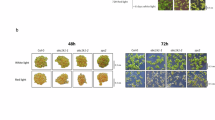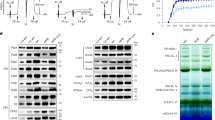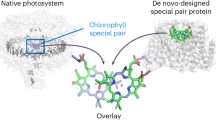Abstract
Chloroplast is a typical plant cell organelle where photosynthesis takes place. In this study, a total of 1 808 chloroplast core proteins in Arabidopsis thaliana were reliably identified by combining the results of previously published studies and our own predictions. We then constructed a chloroplast protein interaction network primarily based on these core protein interactions. The network had 22 925 protein interaction pairs which involved 2 214 proteins. A total of 160 previously uncharacterized proteins were annotated in this network. The subunits of the photosynthetic complexes were modularized, and the functional relationships among photosystem I (PSI), photosystem II (PSII), light harvesting complex of photosystem I (LHC I) and light harvesting complex of photosystem I (LHC II) could be deduced from the predicted protein interactions in this network. We further confirmed an interaction between an unknown protein AT1G52220 and a photosynthetic subunit PSI-D2 by yeast two-hybrid analysis. Our chloroplast protein interaction network should be useful for functional mining of photosynthetic proteins and investigation of chloroplast-related functions at the systems biology level in Arabidopsis.
Similar content being viewed by others
Log in or create a free account to read this content
Gain free access to this article, as well as selected content from this journal and more on nature.com
or
Abbreviations
- TAIR:
-
(the Arabidopsis information database)
- PPDB:
-
(plant plastid database)
- MS:
-
(mass spectrometry)
- PSI:
-
(photosystem I)
- PSII:
-
(photosystem II)
- LHC I:
-
(light-harvesting complex of photosystem I)
- LHC II:
-
(light-harvesting complex of photosystem II)
- GO:
-
(gene ontology)
- GFP:
-
(green fluorescent protein)
- GOM:
-
(global optimization method)
- FDR:
-
(false discovery rate)
- CCs:
-
(correlation coefficients)
- BLAST:
-
(basic local alignment search tool)
References
Westerlund IvHG, Emanuelsson O . Lump – a neural network predictor for protein localization in the thylakoid lumen. Protein Sci 2003; 12:2360–2366.
Friso G, Giacomelli L, Ytterberg AJ, et al. In-depth analysis of the thylakoid membrane proteome of Arabidopsis thaliana chloroplasts: new proteins, new functions, and a plastid proteome database. Plant Cell 2004; 16:478–499.
van Wijk KJ . Plastid proteomics. Plant Physiol Biochem 2004; 42:963–977.
Leister D . Chloroplast research in the genomic age. Trends Genet 2003; 19:47–56.
Baginsky S, Gruissem W . Chloroplast proteomics: potentials and challenges. J Exp Bot 2004; 55:1213–1220.
Ferro M, Salvi D, Brugiere S, et al. Proteomics of the chloroplast envelope membranes from Arabidopsis thaliana. Mol Cell Proteomics 2003; 2:325–345.
Ferro M, Salvi D, Riviere-Rolland H, et al. Integral membrane proteins of the chloroplast envelope: identification and subcellular localization of new transporters. Proc Natl Acad Sci USA 2002; 99:11487–11492.
Froehlich JE, Wilkerson CG, Ray WK, et al. Proteomic study of the Arabidopsis thaliana chloroplastic envelope membrane utilizing alternatives to traditional two-dimensional electrophoresis. J Proteome Res 2003; 2:413–425.
Giacomelli L, Rudella A, van Wijk KJ . High light response of the thylakoid proteome in Arabidopsis wild type and the ascorbate-deficient mutant vtc2–2. A comparative proteomics study. Plant Physiol 2006; 141:685–701.
Kleffmann T, Russenberger D, von Zychlinski A, et al. The Arabidopsis thaliana chloroplast proteome reveals pathway abundance and novel protein functions. Curr Biol 2004; 14:354–362.
Peltier JB, Cai Y, Sun Q, et al. The oligomeric stromal proteome of Arabidopsis thaliana chloroplasts. Mol Cell Proteomics 2006; 5:114–133.
Peltier JB, Emanuelsson O, Kalume DE, et al. Central functions of the lumenal and peripheral thylakoid proteome of Arabidopsis determined by experimentation and genome-wide prediction. Plant Cell 2002; 14:211–236.
Peltier JB, Friso G, Kalume DE, et al. Proteomics of the chloroplast: systematic identification and targeting analysis of lumenal and peripheral thylakoid proteins. Plant Cell 2000; 12: 319–341.
Peltier JB, Ytterberg AJ, Sun Q, van Wijk KJ . New functions of the thylakoid membrane proteome of Arabidopsis thaliana revealed by a simple, fast, and versatile fractionation strategy. J Biol Chem 2004; 279:49367–49383.
Schubert M, Petersson UA, Haas BJ, Funk C, Schroder WP, Kieselbach T . Proteome map of the chloroplast lumen of Arabidopsis thaliana. J Biol Chem 2002; 277:8354–8365.
Ytterberg AJ, Peltier JB, van Wijk KJ . Protein profiling of plastoglobules in chloroplasts and chromoplasts. A surprising site for differential accumulation of metabolic enzymes. Plant Physiol 2006; 140:984–997.
Kleffmann T, Hirsch-Hoffmann M, Gruissem W, Baginsky S . plprot: a comprehensive proteome database for different plastid types. Plant Cell Physiol 2006; 47:432–436.
Yellaboina S, Goyal K, Mande SC . Inferring genome-wide functional linkages in E. coli by combining improved genome context methods: comparison with high-throughput experimental data. Genome Res 2007; 17:527–535.
Ito T, Chiba T, Ozawa R, Yoshida M, Hattori M, Sakaki Y . A comprehensive two-hybrid analysis to explore the yeast protein interactome. Proc Natl Acad Sci USA 2001; 98:4569–4574.
Uetz P, Giot L, Cagney G, Mansfield TA, Judson RS, Knight JR, et al. A comprehensive analysis of protein-protein interactions in Saccharomyces cerevisiae. Nature 2000; 403:623–627.
Giot L, Bader JS, Brouwer C, Chaudhuri A, Kuang B, Li Y, et al. A protein interaction map of Drosophila melanogaster. Science 2003; 302:1727–1736.
Li S, Armstrong CM, Bertin N, et al. A Map of the Interactome Network of the Metazoan C. elegans. Science 2004; 303:540–543.
Stelzl U, Worm U, Lalowski M, et al. A human protein-protein interaction network: a resource for annotating the proteome. Cell 2005; 122:957–968.
Uhrig JF . Protein interaction networks in plants. Planta 2006; 224:771–781.
de Folter S, Immink RG, Kieffer M, et al. Comprehensive interaction map of the Arabidopsis MADS Box transcription factors. Plant Cell 2005; 17:1424–1433.
Hackbusch J, Richter K, Muller J, Salamini F, Uhrig JF . A central role of Arabidopsis thaliana ovate family proteins in networking and subcellular localization of 3-aa loop extension homeodomain proteins. Proc Natl Acad Sci USA 2005; 102:4908–4912.
Geisler-Lee J, O'Toole N, Ammar R, Provart NJ, Millar AH, Geisler M . A predicted interactome for Arabidopsis. Plant Physiol 2007; 145:317–329.
Walhout AJ, Vidal M . Protein interaction maps for model organisms. Nat Rev Mol Cell Biol 2001; 2:55–62.
Buckingham S . Bioinformatics: programmed for success. Nature 2003; 425:209–215.
Matthews LR, Vaglio P, Reboul J, et al. Identification of potential interaction networks using sequence-based searches for conserved protein-protein interactions or “interologs”. Genome Res 2001; 11:2120–2126.
Ge H, Liu Z, Church GM, Vidal M . Correlation between transcriptome and interactome mapping data from Saccharomyces cerevisiae. Nat Genet 2001; 29:482–486.
Grigoriev A . A relationship between gene expression and protein interactions on the proteome scale: analysis of the bacteriophage T7 and the yeast Saccharomyces cerevisiae. Nucleic Acids Res 2001; 29:3513–3519.
Dandekar T, Snel B, Huynen M, Bork P . Conservation of gene order: a fingerprint of proteins that physically interact. Trends Biochem Sci 1998; 23:324–328.
Overbeek R, Fonstein M, D'Souza M, Pusch GD, Maltsev N . The use of gene clusters to infer functional coupling. Proc Natl Acad Sci USA 1999; 96:2896–2901.
Enright AJ, Iliopoulos I, Kyrpides NC, Ouzounis CA . Protein interaction maps for complete genomes based on gene fusion events. Nature 1999; 402:86–90.
Date SV, Marcotte EM . Discovery of uncharacterized cellular systems by genome-wide analysis of functional linkages. Nat Biotechnol 2003; 21:1055–1062.
Huynen M, Snel B, Lathe W, 3rd, Bork P . Predicting protein function by genomic context: quantitative evaluation and qualitative inferences. Genome Res 2000; 10:1204–1210.
Pellegrini M, Marcotte EM, Thompson MJ, Eisenberg D, Yeates TO . Assigning protein functions by comparative genome analysis: protein phylogenetic profiles. Proc Natl Acad Sci USA 1999; 96:4285–4288.
Ermolaeva MD, White O, Salzberg SL . Prediction of operons in microbial genomes. Nucleic Acids Res 2001; 29:1216–1221.
Strong M, Mallick P, Pellegrini M, Thompson MJ, Eisenberg D . Inference of protein function and protein linkages in Mycobacterium tuberculosis based on prokaryotic genome organization: a combined computational approach. Genome Biol 2003; 4:R59.
Sun J, Sun Y, Ding G, et al. InPrePPI: an integrated evaluation method based on genomic context for predicting protein-protein interactions in prokaryotic genomes. BMC Bioinform 2007; 8:414.
Rhodes DR, Tomlins SA, Varambally S, et al. Probabilistic model of the human protein-protein interaction network. Nat Biotechnol 2005; 23:951–959.
Jansen R, Yu H, Greenbaum D, et al. A Bayesian networks approach for predicting protein-protein interactions from genomic data. Science 2003; 302:449–453.
Lee I, Date SV, Adai AT, Marcotte EM . A probabilistic functional network of yeast genes. Science 2004; 306:1555–1558.
Troyanskaya O, Cantor M, Sherlock G, et al. Missing value estimation methods for DNA microarrays. Bioinformatics 2001; 17:520–525.
Small I, Peeters N, Legeai F, Lurin C . Predotar: A tool for rapidly screening proteomes for N-terminal targeting sequences. Proteomics 2004; 4:1581–1590.
Calvo S, Jain M, Xie X, et al. Systematic identification of human mitochondrial disease genes through integrative genomics. Nat Genet 2006; 38:576–582.
Cui J, Li P, Li G, et al. AtPID: Arabidopsis thaliana protein interactome database an integrative platform for plant systems biology. Nucleic Acids Res 2008; 36:D999–D1008.
Schwikowski B, Uetz P, Fields S . A network of protein-protein interactions in yeast. Nat Biotechnol 2000; 18:1257–1261.
Barabasi AL, Oltvai ZN . Network biology: understanding the cell's functional organization. Nat Rev Genet 2004; 5:101–113.
Strogatz SH . Exploring complex networks. Nature 2001; 410:268–276.
Yook SH, Oltvai ZN, Barabasi AL . Functional and topological characterization of protein interaction networks. Proteomics 2004; 4:928–942.
Vazquez A, Flammini A, Maritan A, Vespignani A . Global protein function prediction from protein-protein interaction networks. Nat Biotechnol 2003; 21:697–700.
Khrouchtchova A, Hansson M, Paakkarinen V, et al. A previously found thylakoid membrane protein of 14 kDa (TMP14) is a novel subunit of plant photosystem I and is designated PSI-P. FEBS Lett 2005; 579:4808–4812.
Petsalaki EI, Bagos PG, Litou ZI, Hamodrakas SJ . PredSL: a tool for the N-terminal sequence-based prediction of protein subcellular localization. Genom Proteom Bioinform 2006; 4:48–55.
Yu H, Luscombe NM, Lu HX, et al. Annotation transfer between genomes: protein-protein interologs and protein-DNA regulogs. Genome Res 2004; 14:1107–1118.
The Arabidopsis Genomics Initiative. Analysis of the genome sequence of the flowering plant Arabidopsis thaliana. Nature 2000; 408:796–815.
Frishman D, Albermann K, Hani J, et al. Functional and structural genomics using PEDANT. Bioinformatics 2001; 17:44–57.
Berardini TZ, Mundodi S, Reiser L, et al. Functional annotation of the Arabidopsis genome using controlled vocabularies. Plant Physiol 2004; 135:745–755.
Karaoz U, Murali TM, Letovsky S, et al. Whole-genome annotation by using evidence integration in functional-linkage networks. Proc Natl Acad Sci USA 2004; 101:2888–2893.
Bonaventura CJM . Fluorescence and oxygen evolution form Chlorella pyrenoidosa. Biochim Biophys Acta 1969; 189:366–383.
Altschul SF, Gish W, Miller W, Myers EW, Lipman DJ . Basic local alignment search tool. J Mol Biol 1990; 21:403–410.
Sun J, Xu J, Liu Z, et al. Refined phylogenetic profiles method for predicting protein-protein interactions. Bioinformatics 2005; 21:3409–3415.
Batagelj V, Mrvar A . Pajek – Analysis and visualization of large networks. In: Junger M, Mutzel P, eds. Graph drawing software. Berlin: Springer Press, 2003:77–103.
Chen DC, Yang BC, Kuo TT . One-step transformation of yeast in stationary phase. Curr Genet 1992; 21:83–84.
McNellis TW, Torii KU, Deng XW . Expression of an N-terminal fragment of COP1 confers a dominant-negative effect on light-regulated seedling development in Arabidopsis. Plant Cell 1996; 8:1491–1503.
Wang PC, Wang C, Mi HL, Zhou GY, Yang ZN . Study of subcellular localization of the expressed protein in Arabidopsis thaliana. Chin Bull Bot 2006; 23:249–254.
Clough SJ, Bent AF . Floral dip: a simplified method for Agrobacterium-mediated transformation of Arabidopsis thaliana. Plant J 1998; 16:735–743.
Acknowledgements
We thank the RIKEN BRC in Japan for provision of all full-length cDNA in this study. National Natural Science Foundation of China (grants numbers 30530100 and 90408010), the State Key Program of Basic Research of China (grant numbers 2007CB947600 and 2007CB108800), and Hi-Tech Research and Development Program of China (grant number 2006AA02Z313) supported this project.
Author information
Authors and Affiliations
Corresponding authors
Supplementary information
Supplementary information, Figure S1
The flowchart to construct chloroplast protein interaction network in Arabidopsis thaliana. (PDF 81 kb)
Supplementary information, Table S1
7,592 putative chloroplast proteins from nine different methods. (XLS 1390 kb)
Supplementary information, Table S2
1,720 chloroplast core proteins encoded by the nuclear genome obtained in this work. (XLS 308 kb)
Supplementary information, Table S3
Chloroplast protein interactions integrated by the naive Bayesian Method. (XLS 1455 kb)
Supplementary information, Table S4
Chloroplast protein interactions predicted based on microarray data (Pearson Coefficient >= 0.95) (XLS 534 kb)
Supplementary information, Table S5
Function Annotation With Arabidopsis chloroplast protein interaction network. (TXT 7 kb)
Supplementary information, Table S6
12 predicted protein interactions selected for Yeast two-hybrid experiment (DOC 26 kb)
Supplementary information, Table S7
The Pearson correlation coefficients (CCs) between each comparison pair of nine data sets (XLS 26 kb)
Supplementary information, Table S8
GSP/GSN- the number of protein pairs in given classes that were present in the gold standard positive/negative set of interactions (DOC 42 kb)
Supplementary information, Table S9
The Primers used in this study (DOC 41 kb)
Supplementary information, Data S1
Nine genome-scale data sets of putative chloroplast proteins (DOC 70 kb)
Rights and permissions
About this article
Cite this article
Yu, QB., Li, G., Wang, G. et al. Construction of a chloroplast protein interaction network and functional mining of photosynthetic proteins in Arabidopsis thaliana. Cell Res 18, 1007–1019 (2008). https://doi.org/10.1038/cr.2008.286
Received:
Revised:
Accepted:
Published:
Issue date:
DOI: https://doi.org/10.1038/cr.2008.286
Keywords
This article is cited by
-
H4 acetylation by the NuA4 complex is required for plastid transcription and chloroplast biogenesis
Nature Plants (2022)
-
Chloroplast development and genomes uncoupled signaling are independent of the RNA-directed DNA methylation pathway
Scientific Reports (2020)
-
Exploring dynamic protein-protein interactions in cassava through the integrative interactome network
Scientific Reports (2020)
-
Soybean (Glycine max L. Merr.) seedlings response to shading: leaf structure, photosynthesis and proteomic analysis
BMC Plant Biology (2019)
-
Predicted protein-protein interactions in the moss Physcomitrella patens: a new bioinformatic resource
BMC Bioinformatics (2015)



